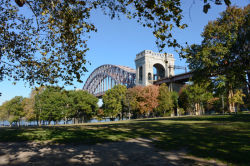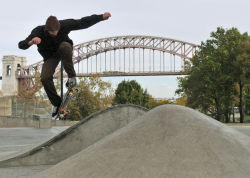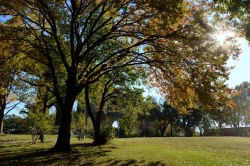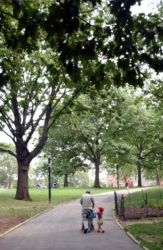Astoria Park
Astoria Pool
For outdoor pool details, including hours and rules, please visit our Free Outdoor Pools page.
What was here before?
At one time local children swam in the Hell Gate tidal strait at the base the natural hillside embankment here, and many drowned in the turbulent waters. The endangerment to citizens in Astoria and at coastal waters throughout the city led to construction of public bathing facilities.
How did this site become a pool?
The summer of 1936, deep in the Great Depression, broke local heat records. Astoria Pool was one of eleven immense outdoor public pools the Parks Department opened that summer. The heroically scaled pools project was financed by the Federal Works Progress Administration (WPA), as part of a massive effort to alleviate adverse health conditions and provide safe recreation in predominantly working-class communities.
The pools were not just huge but also examples of state-of-the-art engineering and fine design. Each pool had separate swimming, diving and wading areas, perimeter bleachers, and bathhouses whose locker rooms served as gyms during non-summer months. Led by architect Aymar Embury II and landscape architect Gilmore D. Clarke, the planning team produced a series of distinct complexes, each one sensitive to its site and topography. Massive filtration systems, heating units, and even underwater lighting provided a more controlled bathing experience than the often treacherous and polluted waterfront currents in which the City’s masses had traditionally swum. The palette of building materials was mainly inexpensive brick, concrete and cast stone, but the styles ranged from Romanesque Revival to Art Deco.
Framed by the Triborough and Hell Gate bridges, Astoria Pool measures 330 by 165 feet and is the largest of the eleven WPA pools. It was designed by John M. Hatton to accommodate 5,570 bathers at a time, and when opened on July 2, 1936 it was described by WPA administrator Harry Hopkins as “the finest in the world.” Metropolitan Opera Company soprano Julie Peters sang at the dedication of the pool, underscoring the pool’s epic quality. It is distinguished by its streamlined and simple forms, decorative glass block, deco-style steel railings, and Art Moderne style ticket booth. In 1936 and 1964, Astoria Pool hosted the Olympic Trials for the U.S. Swim and Diving Teams. In 2006, Astoria Pool was designated an official New York City landmark and remains an invaluable community resource.
Who is this pool named for?
The pool, park, and surrounding neighborhood are named after John Jacob Astor (1763-1848) who was a businessman in the fur trade industry and the first multimillionaire in the United States.
Check out your park's Vital Signs
Clean & Safe
Green & Resilient
Empowered & Engaged Users
Share your feedback or learn more about how this park is part of a
Vital Park System










